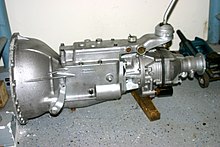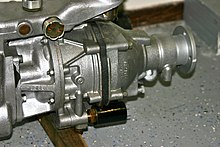
Back Multiplicador de gir Catalan Overdrive (Getriebe) German Overdrive (mecánica) Spanish Overdrive (automobile) French Overdrive (meccanica) Italian Overdrive Malay Overdrive (techniek) Dutch Nadbieg Polish Överväxel Swedish Overdrive (Cơ khí) Vietnamese
This article relies largely or entirely on a single source. (May 2012) |



Overdrive is the operation of an automobile cruising at sustained speed with reduced engine speed (rpm), leading to better fuel consumption, lower noise, and lower wear.[1] The term is ambiguous.[1] The most fundamental meaning is that of an overall gear ratio between engine and wheels, such that the car is over-geared, and cannot reach its potential top speed, i.e. the car could travel faster if it were in a lower gear, with the engine turning at higher RPM.[1]
The power produced by an engine increases with the engine's RPM to a maximum, then falls away. The point of maximum power is somewhat lower than the absolute maximum engine speed to which it is limited, the "redline". A car's speed is limited by the power required to drive it against air resistance, which increases with speed. At the maximum possible speed, the engine is running at its point of maximum power, or power peak, and the car is traveling at the speed where air resistance equals that maximum power. There is therefore one specific gear ratio at which the car can achieve its maximum speed: the one that matches that engine speed with that travel speed.[1] At travel speeds below this maximum, there is a range of gear ratios that can match engine power to air resistance, and the most fuel efficient is the one that results in the lowest engine speed. Therefore, a car needs one gearing to reach maximum speed but another to reach maximum fuel efficiency at a lower speed.
With the early development of cars and the almost universal rear-wheel drive layout, the final drive (i.e. rear axle) ratio for fast cars was chosen to give the ratio for maximum speed. The gearbox was designed so that, for efficiency, the fastest ratio would be a "direct-drive" or "straight-through" 1:1 ratio, avoiding frictional losses in the gears. Achieving an overdriven ratio for cruising thus required a gearbox ratio even higher than this, i.e. the gearbox output shaft rotating faster than the engine. The propeller shaft linking gearbox and rear axle is thus overdriven, and a transmission capable of doing this became termed an "overdrive" transmission.[1]
The device for achieving an overdrive transmission was usually a small separate gearbox, attached to the rear of the main gearbox and controlled by its own shift lever.[1] These were often optional on some models of the same car.
As popular cars became faster relative to legal limits and fuel costs became more important, particularly after the 1973 oil crisis, the use of five-speed gearboxes became more common in mass-market cars. These had a direct (1:1) fourth gear with an overdrive fifth gear, replacing the need for the separate overdrive gearbox.[1]
With the popularity of front wheel drive cars, the separate gearbox and final drive have merged into a single transaxle. There is no longer a propeller shaft and so one meaning of "overdrive" can no longer be applied. However the fundamental meaning, that of an overall ratio higher than the ratio for maximum speed, still applies: higher gears, with greater ratios than 1:1, are described as "overdrive gears".[1]